I’ve written before how difficult it was to get a copy of Sky Team at Essen this year: it’s not out in Europe yet, there was a lot of interest in it leading to queues forming within minutes of the fair opening, and the publisher Le Scorpion Masqué had only a limited quantity on sale each day. That demand would outweigh the supply by at least one order of magnitude was hardly surprising: it’s a great game with a lovely, approachable theme, has gorgeous art and comes in a small box for a very reasonable price. So I made it my very first stop when I entered the convention halls and was happy to have gotten a copy.
In a sense, the situation with World Wonders was similar but worse: a very enthusiastic review by the Dice Tower and not just a few but a whole bunch over over-sized, screen printed wooden monument pieces in the box were two things that surely would attract a crowd. And so it did: I don’t know official numbers, but I read that publisher Arcane Wonder had flown-in between 200 and 400 copies to Essen, all of which were sold in under two hours on the very first day. As fate would have it, their booth was situated between Le Scorpion Masqué’s and that of Delicious Games where I had planned to pick up Evacuation. And so on a whim, I spontaneous decided to take a little detour …
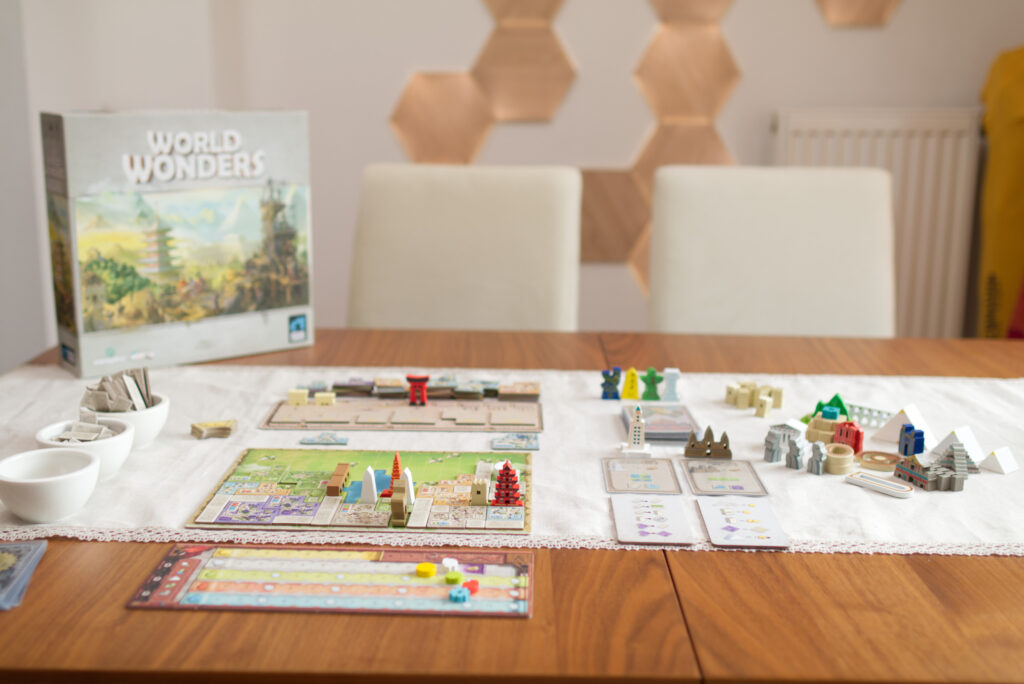
Setup
When simply looking at photos, most people in the hobby would be surprised to learn that World Wonders is not a Kickstarter game and they are not looking at a deluxified version. There is only a single edition that comes in a standard Ticket to Ride-sized box and contains not only a surprising amount of large wooden pieces, but alas, a surprising amount of large screen-printed wooden pieces!
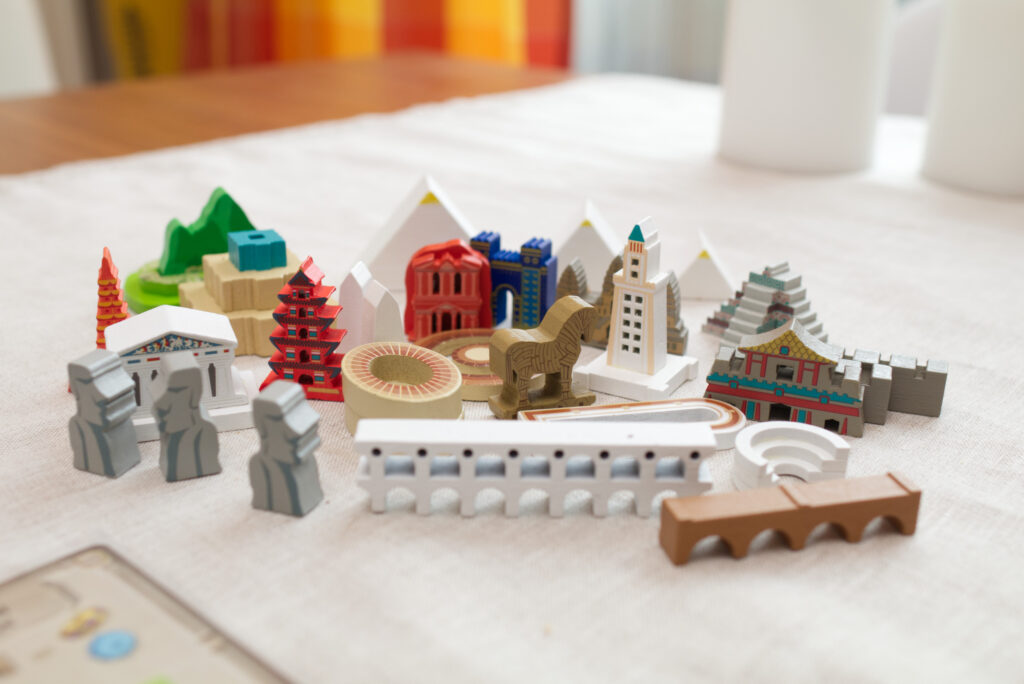
So gamer or not, the first reaction when opening the box is typically that bystanders grab some of those pieces and utter noises of delight and amazement. It’s definitely an unusual look: instead of the plastic minis we’re nowadays so familiar with, there are a couple of normal, single-layer player boards, some cards, a whole bunch of small cardboard tiles, and all those glorious wooden pieces. From the famous colosseum to Machu Pichu and obelisks to the great pyramids, there’s something for everyone and in various shapes and sizes. As a nice touch, the rulebook contains two pages just with small blurbs about each monument … which also might be motivated by the fact that the rules of the game themselves are rather short. The whole rulebook including solo mode, advanced play, components and those monument descriptions fits on just 8 pages. Honestly, after having dug through the rules of Voidfall lately, I find this refreshing.
Let’s get the elephant out of the room: yes, the monuments are super cute and photograph well, everybody likes them. With that out of the way, the rest of these first impressions will mostly ignore them and talk about the underlying game instead.
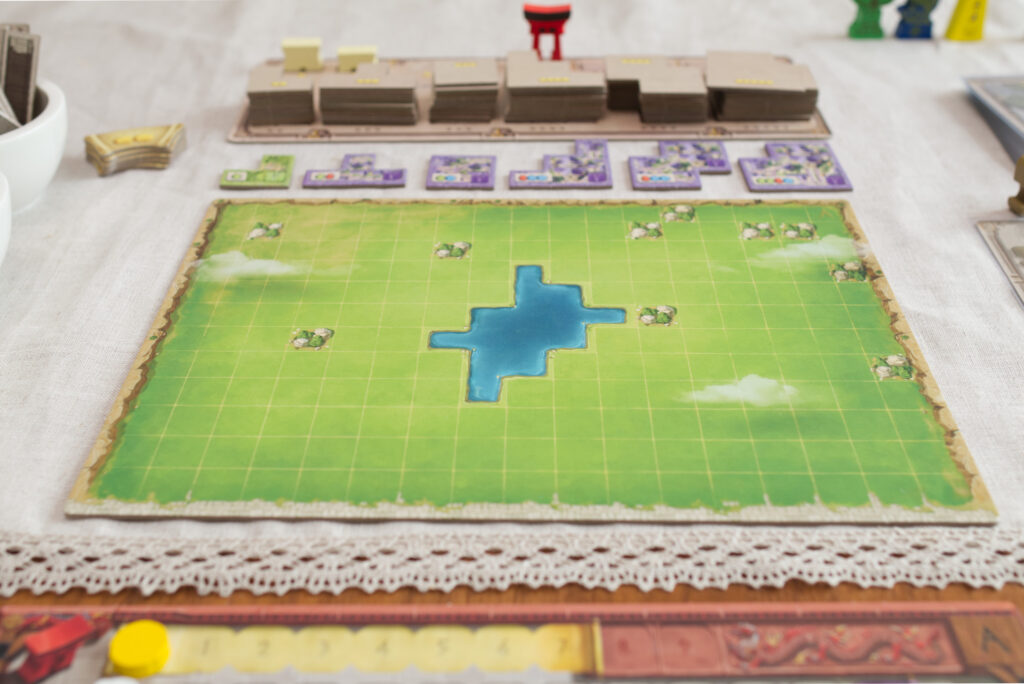
Setup itself is simple: each of the up to five players gets a map boards (all are the same with an A and B side that has a different layout of where the water squares are) and a resource board showing a bunch of tracks on which each a tiny resource marker is placed. Gold basically represents action points players can buy stuff with, the population track can lead to VP and ending the game early, and the three resources tracks are showing how many of those symbols players have collected with the building they bought (and also provide VP). More on those tracks later. All the wooden pieces as well as the various street cardboard tiles are put aside into a common supply .
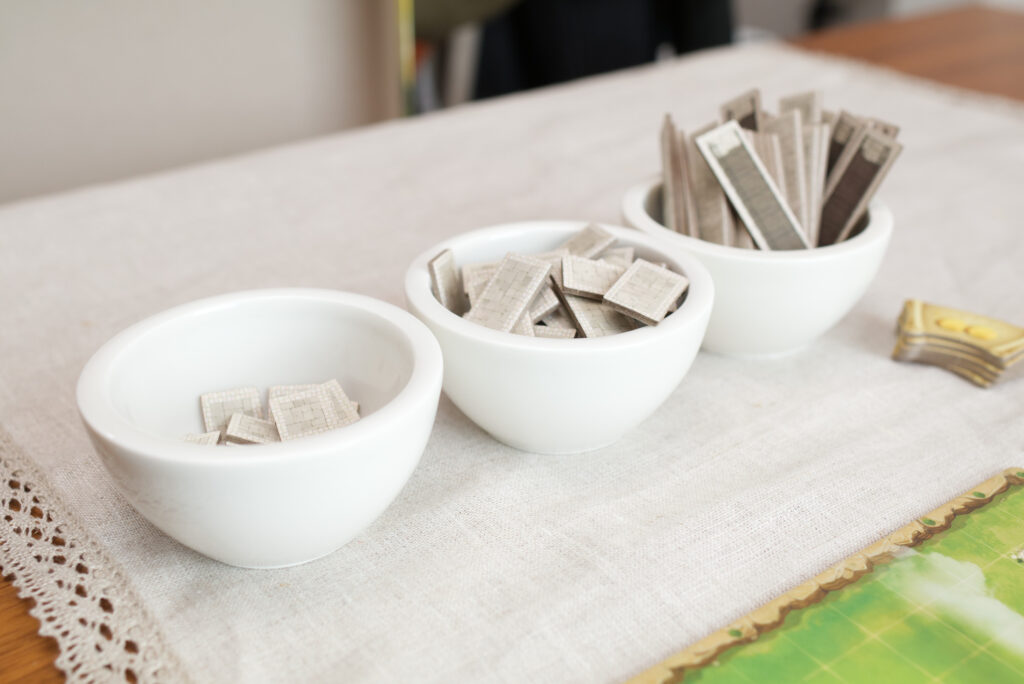
The rather small main board has spaces for the 6 shapes of buildings, each of which relate to a stack of 10 building cardboard tiles with that shape. In a four or five player games, additional side boards and building shapes come into play to compensate for the higher player count. Finally, 3 cards from the monument card deck are revealed and the game can begin.

The Turn
World Wonders usually plays out over ten rounds, but it’s not unusual that a rushing players might trigger an early end in round nine or maybe even round eight. At the beginning of each round, any face-up building tiles that weren’t purchased in a previous round are discarded a new set is revealed, one of each type. In addition, a tower piece and two sets of streets are placed along them: one consists of a single large street, the other of three small streets.
When it’s a player’s turn, they have a few basic options: buy one of the face-up buildings that’s still available and place it on their map board, buy the single per turn available tower again place it on their map, a street-set, buy a cute pedestal to indicate they become first or second player in the next round’s player order, or get out of the current round and take one of the available monuments.
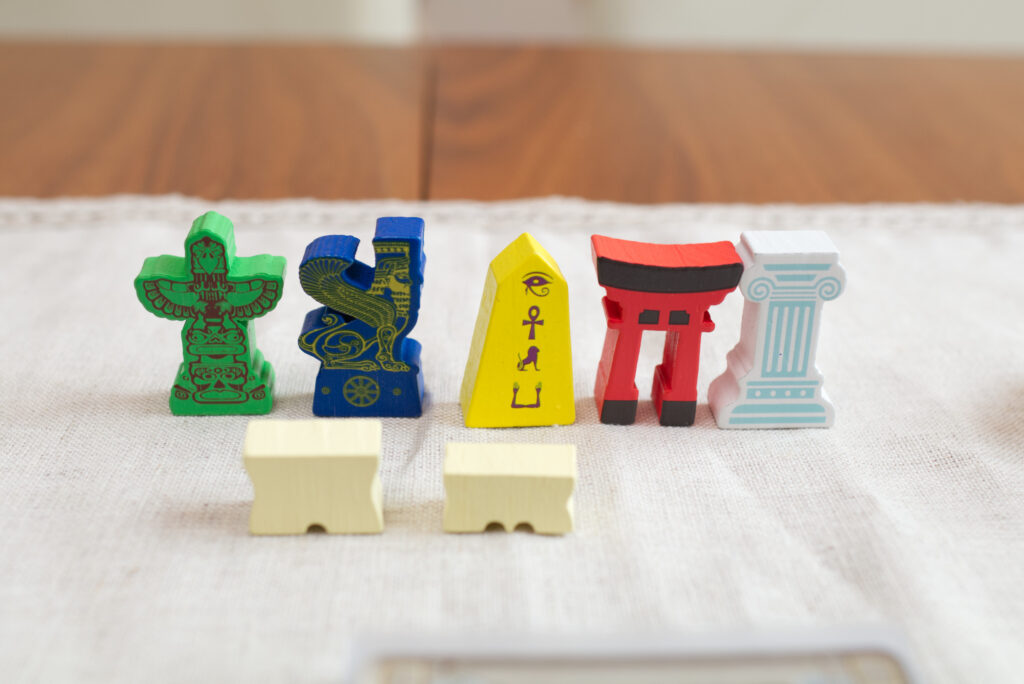
Each player starts off with 7 virtual pieces of gold to spend which can be extended to 9 by taking a loan token. Instead of handing out currency tokens to the players, they all have a gold track on their board and move the marker to track their spendings. Whenever they reach the end of the track, they are automatically out for the remainder of the round.
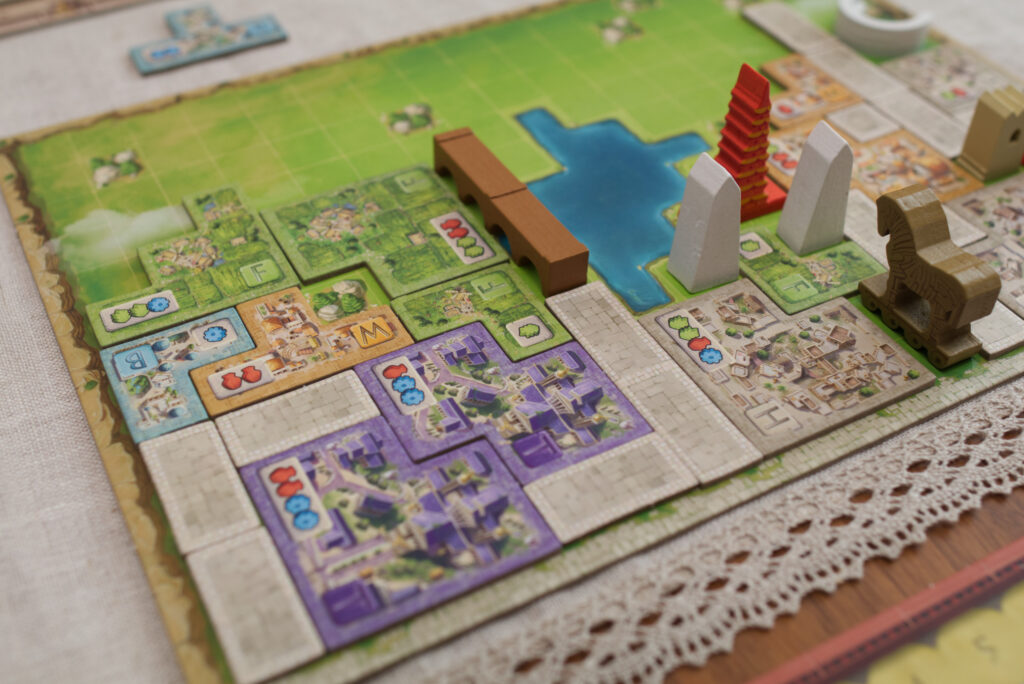
Placement of buildings is simple: a building has to be next to a street or a building of the same type/colour. A street has to be next to another street or the side walk, the lower edge of the player’s map board. A tower can be placed next to anything the player already has on the board and offers a new starting point for streets. Getting a tower if often an act of desperation if one simply was too eager to build buildings and might have inadvertently cut off all streets from any chance to extend them. It costs an action and 2 golds, so should usually be avoided.
So far so simple: the active player buys a street, tower, or building and places it on their map, moves their resource marker for gold to track the spending. Each building also shows a combination of resource symbols (red, blue, green) that correspond to tracks on the player’s resource board. Whenever a building is placed, the corresponding markers go up and if they pass over a square that contains a white head, the white population marker is advanced as well.
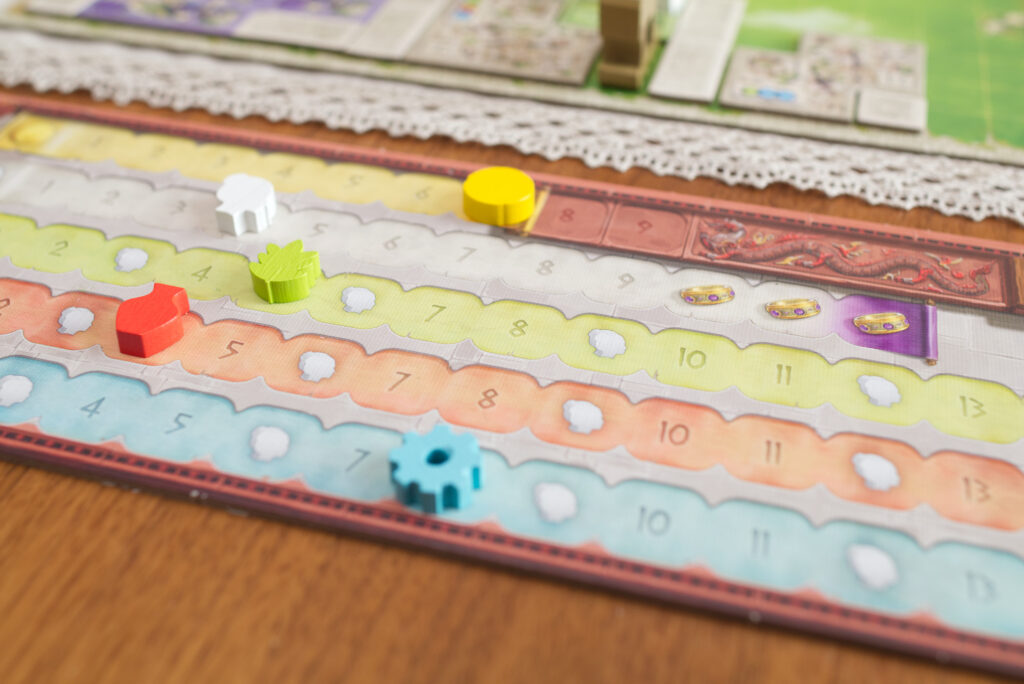
Of course there are lakes and river squares (on which no buildings can be build), squares one wants to be adjacent to but not overbuild (called natural resources), and the reverse of the long street tiles can be used as bridges. It’s all pretty classic tile layer city building stuff. Where things get spicy are the monuments. At any time during the game, there are always three monument cards face up in the common display. Each shows how many victory points (one or two) and resource symbols that monument will earn the player that builds it. They also come with a building instruction that shows the pattern, type of land, and adjacency that is needed. For example, the roman bridge is four squares long, the start and end need to be on land squares, one square needs to be water, and the final square can be either water or land. Also it needs to be adjacent to a street and a farm (a green building).
Monuments do not have a price. Any player that has a legal location where all the building conditions are met can take the card, place the corresponding wooden piece on their map, and earn the points and resources. The problem is: if they do so, they lose all remaining gold and are out for the round.
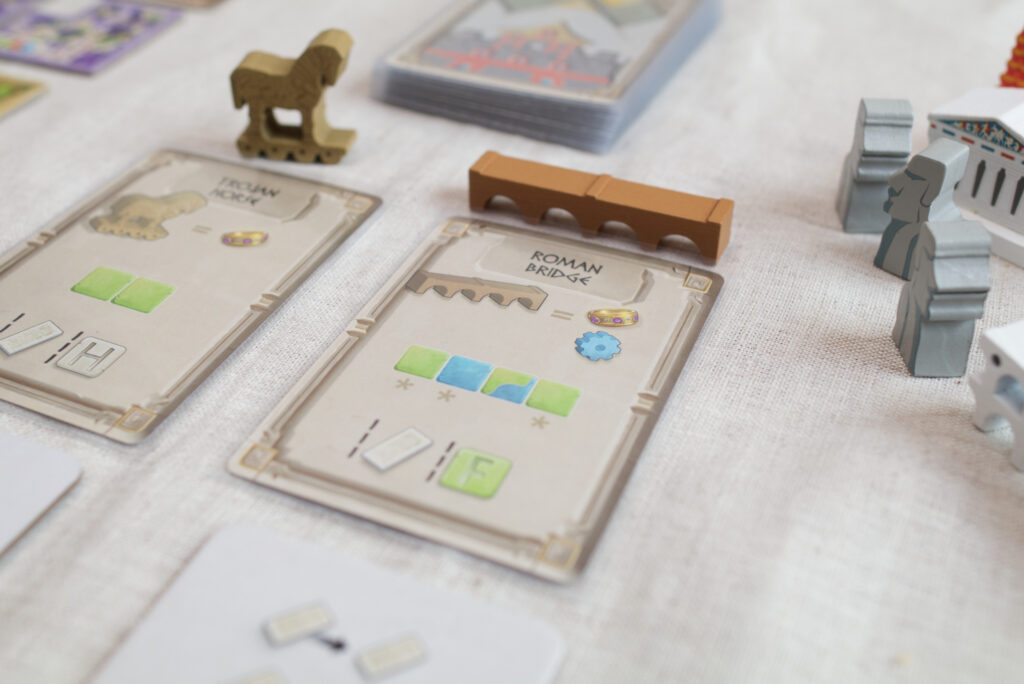
That final rule creates an interesting dynamic: players want to get lots of building tiles because the lowest of their three resources will be converted into VP at games end but also because any building that has no free square next to it scores a VP. On the other hand, getting a monument not only provides tremendous bragging rights but also a welcome extra VP for not that much gold. Typically players will spend all they can and then try to exit with only one or two pieces of gold remaining. However, since anybody can see a monument’s building requirement and whether or not an opponent might be able to build it or not, timing is important. If a player waits too long, the monument they had been planning on might already be gone. If they pick it up too soon, they waste gold they might have spend to buy something else that would have been helpful.
And of course other players will snatch away those building types you yourself needed so you won’t be eligible for any of the monuments at all!
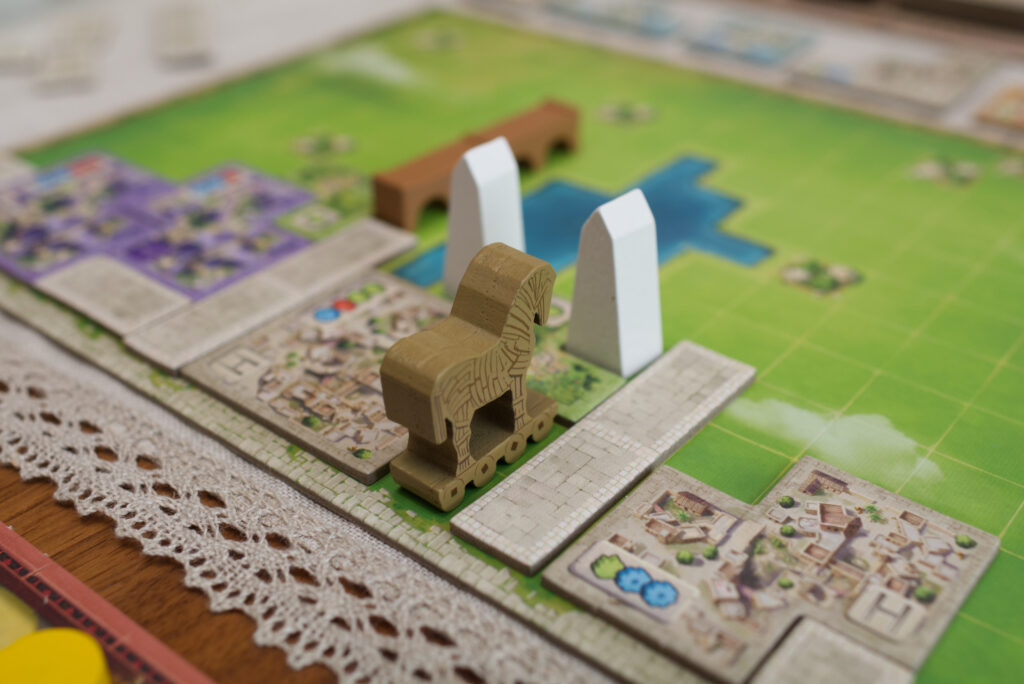
Game End
The game ends after the tenth turn or at the end of the round where any player was able to max out their population track. The shared main board is flipped over and the turn order pieces are used to track the final scores. Fun fact: it took me ten plays to notice the scoring track on the reverse of the main board.
VP (symbolised by a ring) come from various sources: the final three steps on the population track each provide one, each monument provides 1-2 VP, each natural resource square that touches one of the things you placed on your map provides a VP, the lowest of the three resource markers (red, green, blue) provides VP equal to the step its on, and finally – here’s the kicker – each building that has no empty grass square next to it provides a VP.
The last part must be stressed because of course new players instinctively go for the monuments. It’s like playing the very first Civilization on PC all over again: I’m pretty sure I’m not the only one that back then tried to build ALL the shiny world wonders into a single city and reloaded the game when one of those pesky computer players had somehow managed to ruin it and build a wonder in one of THEIR cities. In World Wonders though, monuments are not the primary source of VP. I had plays where the winning player had a huge lead but only had scored like 5 monuments. Me on the other hand, I had build a monument every single round but also compromised not only the amount of buildings I was able to build but also not paid attention that I cut off all my streets and had to buy a tower next round.
Solo Mode
The solo mode in World Wonders comes in the form of a small deck of priority-action cards: reveal one, try the first option and take away that building tile, street set, or monument. If that is not possible, try the second option printed on the card, and if that fails the third. At the end of the game, it scores the values of all your three resource markers (so the sum instead of the lowest) and doesn’t score anything it did on its own.
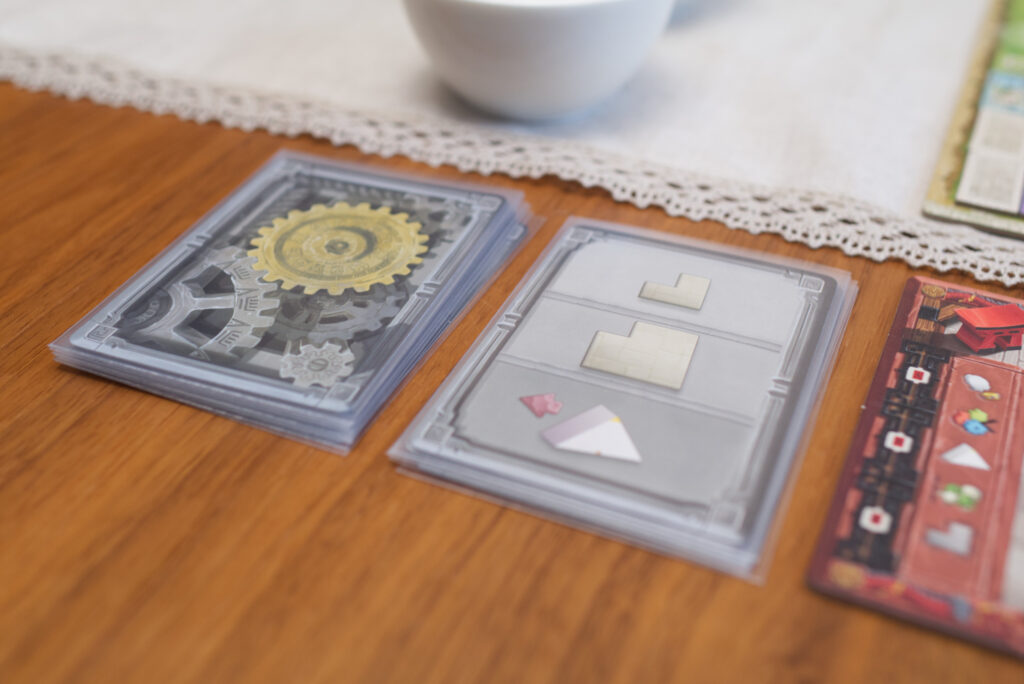
While it works and is low overhead, it feels like a missed opportunity. In a multiplayer game, a huge part of the pressure comes from other players a) specifically contesting the monuments you might be able to build or b) taking buildings of types someone needs to even be eligible for a monument. None of the automa cards even cares about what monuments are on display. It would have been very easy to have cards in there that pick a building not by shape but by type based on the active monuments. Or give the human player a hint what monument the automa is trying to build. It’s also surprising that the advanced play cards are not integrated into the solo mode at all. That could have been an easy win for replayability.
The other issue I have is that this is an automa that changes the game that is played. By scoring the human player’s resource markers, different calculations and compromises compared to the multiplayer version have to be made. It’s still a good puzzle and I often lost to the automa. But this kind of “not real player” type of solo mode is something I personally don’t enjoy. It’s the same problem as with Maglev Metro’s solo mode: would love to play the multiplayer game solo, but that’s not what I’m getting here.
Having a full-fledged virtual opponent that actually uses a map would have been next to impossible. But still, the solo mode feels like a compromise that was added to a game that should be played multiplayer. And it didn’t need to be. I wouldn’t be surprised if a BGG user comes up with a clever alternative automa.
Advanced Play
There is also an optional module in the box that can be added in later plays: three public goals are drawn that show various building conditions. Think monuments on steroids: have a combination of buildings of one type that together touches a large number of specific features, and so on. Each player that manages to fulfil that condition at game end gets additional VP.
I haven’t played with it yet and didn’t feel the need to, but it sounds like a nice throw-in.
Conclusion
When I started writing these first impressions, I to be honest hadn’t thought they would even be this long – and I consider this a rather short one compared to my other pieces. Yes the monuments are lovely, yes, they are fun to play with, but in the end World Wonders is a rather straight forward tile layer. But similar to Foundations of Rome, a game doesn’t need to have complex rules to lead to interesting situations.
Where World Wonder succeeds is the interplay between the three main sources of VP: lowest resource marker, enclosed buildings, and monuments. Remove any one of those and the result would have been a very boring game. If a players goes too much for the monuments, they will run in trouble by not encircling enough buildings or running out of places to build streets. They needed to raise certain buildings quickly before another player could also completes the conditions to pick up the same monument. If a player goes just for encircling buildings, they will lose on potential VPs provided by the monuments as well as having additional pieces to encircle further buildings. While being able to construct a monument requires some pre-planning, it in reality often costs only one gold to actually take it compared to the 4-5 gold of the large buildings cost.
The building-next-to-street rule is also a nice touch I hadn’t experienced in that way yet. You wouldn’t believe in how much trouble you can get another player by simply buying one of the street sets before they have a chance to. But again, it’s not that World Wonders would leave it at that but it sprinkles this little extra of “oh, you can also build a building without a road if it’s next to a building of the same type” rule in. That led to for example a colleague of mine building super action-efficiently as he created giant clusters of the same building type and didn’t have to concern with streets much.
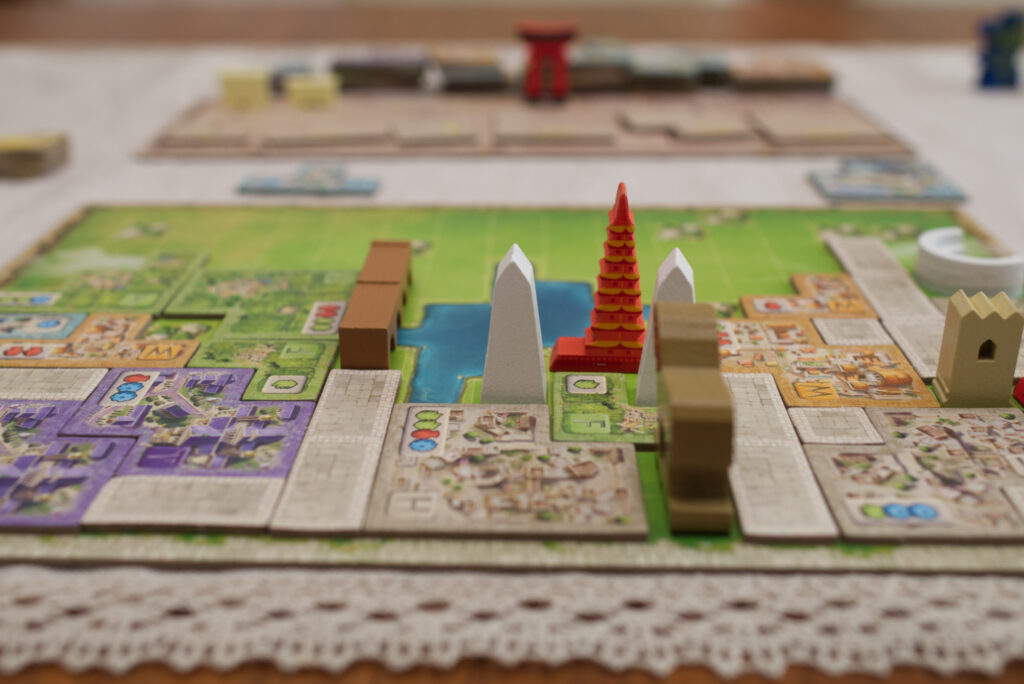
But as nice as the wooden pieces are and as fun as the buying and building of tiles is, I would say this game is very good, but not outstandingly so. This is no Carcassonne that will shock your gaming group and have you playing it over and over and over again. If it weren’t for the wooden monuments that definitely contribute to the pleasant experience, we probably wouldn’t be talking that much about this game. Foundations of Rome had its tons of minis, World Wonders has its wooden bits. Ignoring the visuals and purely from a game mechanical view, I would say FoR has World Wonders beat because there is such an interesting dynamic in it due to its overbuilding-rule. But World Wonders has the more approachable mechanisms that more players, especial casual ones, will want to play. Or in other worlds: this is the perfect game to take home on Christmas and play with the family. They are guaranteed to have a good time and I still have a good challenge.
The other downside of World Wonders is that it can overstay its welcome, especially with AP-prone players. I had a 3p game that was fine and took a nice 60min, but another with more heavy gamers was in the 90-120min range. The game noticeably dragged which was unexpected for a game that appears so approachable and seems like stress-free goodness. I can’t really remember what happened there, it might have been a fluke, or it might have been everyone trying to aggressively block what others wanted to achieve.
I think the biggest gripe I have with World Wonders is that the monument building instructions use stars, less-than-signs, and dotted lines that not only don’t look good but also are ambiguous … or at least leave a lot of room for interpretation. Luckily it’s nothing a little bit of digging in the BGG forum wasn’t able to fix, but in such a family-friendly game, I would have expected a more intuitive iconography or at least better examples in the rules.
So to sum it up: I think World Wonder is a good game and an even better experience. It’s the perfect game to get casual players to play but keep more experienced players interested. Do you have someone in your life that doesn’t like board games? Show them those screen printed monuments and the effect will be similar to just having handed them a young puppy. Players can either just build their city and have fun looking over what they created or actively block others, be action efficient, and squeeze out the last bit of resource advancement out of their limited allowance of gold. The market and monuments automatically lead to choke points and interaction even if each player can do their own thing on their own board.
World Wonder is endearing and disarming, but there is also more cleverness and gameplay in there than I had come to expect from a tile layer. At the end of the day though, I don’t see this coming to the table much in my groups and the solo mode is not attractive enough for me to get it out on my own. Still, it’s good to have it in the collection for when you want some easy good-time fun with the occasional screwing over of your co-players. So I wouldn’t call it a must-buy, but definitely a good-to-have in almost everybody’s collections.
